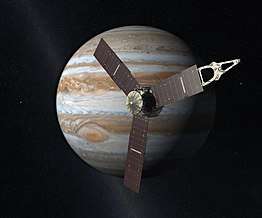(471325) 2011 KT19
(471325) 2011 KT19 (nicknamed Niku; /niːkuː/) is a trans-Neptunian object that has an unusual 110° tilted solar orbital plane and retrograde orbit around the Sun.[2][6][7]
| Discovery [1] | |
|---|---|
| Discovered by | Mount Lemmon Srvy. List
|
| Discovery site | Mount Lemmon Obs. |
| Discovery date | 31 May 2011 |
| Designations | |
| Pronunciation | /niːkuː/ |
Named after | A Chinese adjective meaning "rebellious" [2] |
| TNO [3] | |
| Orbital characteristics[3] | |
| Epoch JD 2457600.5 | |
| Uncertainty parameter 2 | |
| Observation arc | 1779 days (4.87 yr) |
| Aphelion | 47.427 AU |
| Perihelion | 23.7805 AU |
| 35.604 AU | |
| Eccentricity | 0.33208 |
| 212.45 years | |
| 29.487° | |
| Inclination | 110.1537° |
| 243.77772° | |
| 322.174° | |
| TJupiter | −1.552 |
| Physical characteristics | |
| Dimensions | 75–250 km[4] |
| 22[5] | |
| 7.2[4][3] | |
Details
(471325) 2011 KT19 was discovered by the Mount Lemmon Survey on 31 May 2011. Its rediscovery was announced in August 2016 by a team of astronomers using the Pan-STARRS telescope. It was soon linked with a supposed prograde centaur (2011 KT19; inclination = 38° and semi-major axis = 28 AU) that had been lost due to a short observation arc.[1][6] 2011 KT19 is in a 7:9 resonance with Neptune. Currently it is the only object with a nearly polar orbit that is in resonance with a planet.[8] Notably, it is part of a group of objects that orbit the Sun in a highly inclined orbit; the reasons for this unusual orbit are unknown as of August 2016.[9]
The orbital characteristics of 2011 KT19 have been compared to those of 2008 KV42 (Drac). The orbits of 2011 KT19, 2008 KV42, and four other objects appear to occupy a common plane, with three in prograde and three in retrograde orbits. The probability of this alignment occurring by chance is 0.016%. These orbits should leave a common plane in a few million years because the precession of prograde and retrograde orbits are in opposite directions. Simulations including the hypothetical Planet Nine did not maintain a common orbital plane and the plane does not coincide with the plane of the predicted high-inclination large semi-major axis objects of that model. Other simulations with a few Earth-mass dwarf planet on a high-inclination orbit also failed to reproduce the alignment.[6]
 |
| The orbit of 2011 KT19 in relation to Pluto and the planets of the Solar System |
 |
| The orbit of Niku (purple), is shown with another steep retrograde TNO, Drac (yellow), and the other planets. Pluto's orbit is in red. |
References
- "MPEC 2011-L09 : 2011 KT19". IAU Minor Planet Center. 2 June 2011. (K11K19T; E-assumed due to short arc)
- "Mystery object in weird orbit beyond Neptune cannot be explained". New Scientist. 10 August 2016. Retrieved 11 August 2016.
- "JPL Small-Body Database (2011 KT19)". JPL. NASA. Retrieved 12 August 2016.
- "IAU Minor Planet Center - 2011 KT19". Minor Planet Center. IAU. Retrieved 12 August 2016.
- "AstDyS (471325) 2011KT19 Ephemerides". Retrieved 18 February 2017.
- Chen, Ying-Tung; Lin, Hsing Wen; Holman, Matthew J; Payne, Matthew J; et al. (5 August 2016). "Discovery of A New Retrograde Trans-Neptunian Object: Hint of A Common Orbital Plane for Low Semi-Major Axis, High Inclination TNOs and Centaurs". The Astrophysical Journal. 827: L24. arXiv:1608.01808. Bibcode:2016ApJ...827L..24C. doi:10.3847/2041-8205/827/2/L24.
- "What Makes the Solar System Like a Crime Scene? - Science Friday". 19 August 2016. Retrieved 19 August 2016.
- Morais, M. H. M.; Nomouni, F. (2017). "First transneptunian object in polar resonance with Neptune". Letters. Monthly Notices of the Royal Astronomical Society. arXiv:1708.00346. Bibcode:2017MNRAS.472L...1M. doi:10.1093/mnrasl/slx125.
- Dalton, Andrew (10 August 2016). "There's something weird going on beyond Neptune". Engadget. AOL. Retrieved 11 August 2016.


